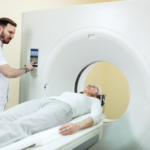Pediatric imaging is used to diagnose and address various health conditions in children. Concerns about radiation exposure underscore the need for specialized approaches that prioritize safety. Advances in technology and tailored imaging practices are helping providers minimize radiation while maintaining high-quality diagnostic results.
Understanding the Need for Pediatric Imaging
Pediatric imaging is a specialized field of diagnostic radiology that focuses on children and teens. Accurate imaging is necessary for detecting injuries and monitoring chronic conditions. As well as diagnosing illnesses that may not be apparent through physical exams or blood tests alone. Children’s bodies differ from adults in many ways. This includes their size, development, and the types of health issues they may face. Imaging specialists are trained to account for these differences, allowing them to use the appropriate techniques for each patient’s age and condition.
The Challenge of Radiation in Pediatric Imaging
The use of radiation in procedures such as X-rays and CT scans has long been a concern, particularly for children. Unlike adults, children are more sensitive to radiation due to their smaller body size and longer life expectancy, increasing the cumulative risk of long-term complications from repeated exposure. Minimizing radiation while obtaining clear, accurate images is a delicate balance unique to pediatric care. Unnecessary imaging or too-high doses can result in exposure that could have been avoided with alternative methods or equipment adjustments.
Innovations in Pediatric Imaging
To address these challenges, new technologies and practices have been developed to reduce radiation dose in imaging. These include:
- Low-Dose Imaging Techniques: Advanced equipment captures high-resolution images with lower radiation doses, calibrated for children’s smaller bodies to limit exposure. This allows for accurate diagnostics while prioritizing patient safety.
- Alternative Imaging Modalities: MRI and ultrasound offer radiation-free options. MRI is ideal for soft tissues, the brain, and the spine, while ultrasound excels in evaluating abdominal or pelvic conditions. These alternatives provide effective and safe solutions for a wide range of medical needs.
- Tailored Protocols for Children: Imaging facilities use age- and size-appropriate protocols to minimize exposure without sacrificing image quality. Every protocol is designed with a child’s comfort and safety in mind.
- Improved Software and Monitoring: Advanced software monitors radiation levels with automated dose tracking systems to minimize cumulative exposure. This technology provides consistent oversight for long-term safety.
The Role of Parents and Healthcare Providers
Both parents and healthcare providers can actively promote safer imaging practices. Parents can advocate for the lowest radiation dose possible by asking questions and making sure their provider specializes in pediatric care. Minimizing radiation is a delicate balance. Alternative methods or equipment adjustments can often avoid unnecessary imaging or overly high doses.
Prioritizing Safety and Accuracy in Pediatric Imaging
Pediatric imaging balances accurately diagnosing conditions and protecting children from unnecessary radiation. Innovations in imaging technology and child-specific protocols have made significant progress in managing this balance, making sure both effective care and safety. Parents and guardians can make decisions by staying informed about the imaging options available to their children. Feel free to consult your provider or specialist if you have questions about any imaging technique or procedure for your child.







